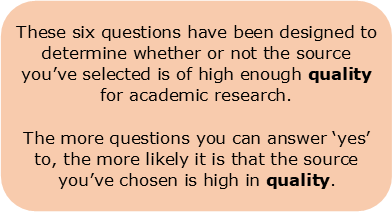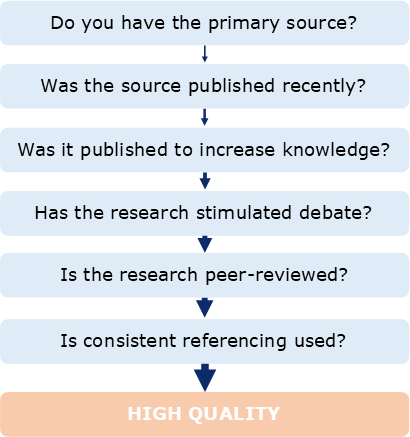What determines a high-quality academic source?

This is the third and final chapter about Identifying Source Value. To complete this reader, read each chapter carefully and then unlock and complete our materials to check your understanding.
– Explore the concept of source quality in academic research
– Provide six questions for determining source quality
– Use examples to help explain these concepts and guide the reader towards finding appropriate academic sources
Before you begin reading...
-
video and audio texts
-
knowledge checks and quizzes
-
skills practices, tasks and assignments
Chapter 3
Over the past two chapters about identifying source value, we’ve explored seven methods for quickly judging the value of a source and six questions to ask yourself when determining whether or not a source is appropriate for academic research. In this final chapter, let’s now take a look at six more questions that a keen researcher should ask themselves to determine whether or not the source they wish to include in their work is of sufficiently high quality.


1. Do you have the primary source?
As was mentioned in some detail in our reader on finding academic sources, there’s a fundamental difference between primary and secondary sources that researchers should take into consideration when determining the quality of a source. As the following table demonstrates, primary sources are generally of more value to a researcher because they contain the original research:

By finding and reading the primary source instead of reading someone’s discussion of that research in a secondary source, the researcher will limit the number of interpretations of that particular source and therefore also limit the loss of information over time. That’s not to say that secondary sources aren’t still valuable to researchers, particularly as tools for explaining or directing you back to the original source. Primary sources, however, are ultimately always preferable, particularly as you delve further into your research and academic career.
2. Was the source published recently?
While a recent source doesn’t always mean a quality source, the newer the publication is the more likely it is to contain up-to-date methodology and cutting-edge research. This doesn’t mean that the more dated sources aren’t useful however, particularly for providing background information or introducing a concept or theory. In fact, one marker of high-quality research might be that the original source has withstood the test of time – although it’s also true that there will probably be newer publications about that topic that will concisely summarise the many years of past discussion. Either way, although recent research is generally advisable for inclusion in academic essays, it still takes a few years for the academic community to respond to or provide counter arguments against a hypothesis. It might therefore be preferable to start with academic research that’s already been in circulation for between five and fifteen years.
3. Was it published to increase knowledge?
Another test of quality is to consider the primary reason for why a particular source was created. Some casual research may indicate that an author has their own agenda for creating a book or journal article, publishing for money, fame or to increase their own upward mobility. More likely, and easier to determine, are the companies that may have funded research in order to find particularly favourable results, perhaps for products they promote or sell. If you’re reading a journal article that’s been funded by Coca Cola for example about how sugary drinks benefit a person’s health, or are in possession of a newspaper article that’s commonly known to be politically biased, you can expect these sources to be of lower quality than those that have been written solely for the purpose of increasing public knowledge.
4. Has the research stimulated debate?
Any piece of research that other academics have struggled to disprove over the years, that has encouraged significant debate from both proponents and sceptics, or that is still frequently cited decades after its creation is usually one of enviably high quality. Because it takes robust methodology, original ideas and significant levels of insight and validity for a piece of research to stimulate years of considerable debate, when you find a source or author that has succeeded in doing so, you should most certainly consider including this valuable source within your research.
5. Is the research peer-reviewed?
If there’s one filter that you should always have applied when using a university library’s search engine, it’s the eponymous ‘peer-review’ filter. Commonly applied to journal articles, a source that’s been peer-reviewed is a source that’s been carefully checked by other researchers prior to publication for both the quality of its methodology and the logicality of its implications. While the peer-review filter may not be an absolute indicator of quality, you can be assured that that source should be of a higher quality than most others, making it therefore more appropriate for academic research.
6. Is consistent referencing used?
Finally, and while not a guarantee of quality, any source that maintains consistent referencing practices is one that at least attempts to follow high academic standards. By appropriately including citations and references within a reference list, other researchers should be able to investigate that source’s evidence and claims, making the argumentation of that source more trustworthy and refutable. Seeing as one of the fundamental skills of academic writing is to provide a convincing argument, and that referencing practices help to do that, consistent referencing would appear to almost certainly increase the quality of a source.
Having come to the end of this short reader on identifying source value, you may now wish to test your knowledge of this topic by accessing, downloading and completing our related beginner, intermediate and advanced worksheets.
Downloadables
Once you’ve completed all three chapters about identifying source value, you might also wish to download our beginner, intermediate and advanced worksheets to test your progress or print for your students. These professional PDF worksheets can be easily accessed for only a few Academic Marks.
Collect Academic Marks
-
100 Marks for joining
-
25 Marks for daily e-learning
-
100-200 for feedback/testimonials
-
100-500 for referring your colleages/friends